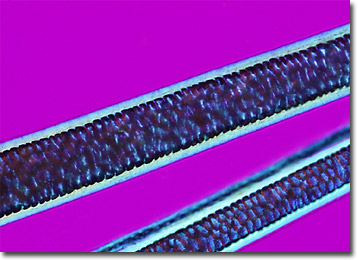Polarized Light Microscopy Digital Image Gallery
Sable Hair
Since the Stone Age humans have utilized furs for keeping warm, and more than 5,000 years ago wearing the furs of certain animals became a status symbol signifying oneís affluence. In modern times, garments made from particular species, such as mink, ermine, and sable, are still prized as luxurious markers of oneís wealth, despite stringent efforts by animal rights activists.

View a second image of Sable Hair
Martes zibellina is the scientific name of the true sable, though several other species are also sometimes referred to as sables. Native to northern portions of Asia, the fur of the carnivorous animal is thick and soft, providing it adequate warmth and protection from the cold climates it typically inhabits. The color of the fur ranges from brown to nearly black, and a lighter-hued throat patch and silver flecks are sometimes present. Human demand for the animalís splendid coat has greatly reduced wild populations, but the animal is now ranched in various locales, though primarily in Russia.
Similar to other species in the weasel family Mustelidae, the sable is long and agile. Its body may grow as many as 20 inches long and its tail adds another several inches to its slender form. The mammal, which only weighs two to four pounds, is a natural climber that prefers to spend most of its time in trees, where it feeds upon eggs, birds, and any other small animals it is able to capture. Generally solitary in habit, sables only couple for breeding purposes and their gestation period is uncommonly long, lasting as many as 300 days. This unusual characteristic is caused by a significant delay in the implantation of the fertilized egg in the uterine wall.
